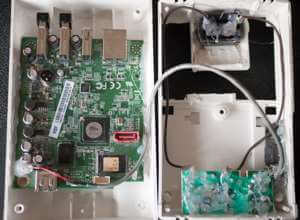Dropping the F-BOMB, A Disposable Spy Computer Funded by DARPA

Share
Attach a camera to a drone, fly the drone around the back of the house, locate the bad guys. Robotic UAVs are being used for surveillance by everyone from the military to local law enforcement to emergency personnel. But if you think about it, drones are kind of big and really noisy, not the ideal tool for spying on someone. Their data gathering capabilities are limited too and they’re really expensive. What about a computer, small and durable enough for you to toss over a fence or inconspicuously attach to a car? Equipped with Wi-Fi cracking software or GPS, it could infiltrate someone’s computer or track someone’s location without them knowing.
Allow me to drop the F-BOMB. The Falling or Ballistically-launched Object that Makes Backdoors, that is. Invented by Brandon O’Connor as an alternative to high-tech and costly spy devices, the F-BOMB is made so cheaply with off-the-shelf parts that you’ll feel perfectly okay with losing one or two. Very convenient when it’s sitting in the backyard of a drug lord hideout.
Before building the F-BOMB, O’Connor challenged himself with several constraints. He wanted multiple wireless radios, USB capability for expansion (add GPS for example), battery life that lasted hours to days, a size small enough that it won’t be found by the “bad guys with guns,” as he calls them, and do all this without spending thousands or even hundreds of dollars.
The key addition was the PogoPlug. The PogoPlug is a NAS (Network Attached Storage) box, a data storage device through which people can share information over the Internet. It runs on Linux which makes it pretty user-friendly, according to O’Connor. Normally the boxes cost about $150, which would have made the F-BOMB too expensive for O’Connor’s purposes, but the company is having a hard time selling the devices. PogoPlug’s misfortune becomes O’Connor’s advantage as he can now purchase them for just $25 on Amazon.com. And that’s the most expensive bit of hardware. Add the antennae, eight gigabytes worth of flash memory and a plastic casting that’s 3D-printed and you’ve got a little spying computer you can build for under $49. Four D batteries will provide power for 30-plus hours.
Aside from being cheap and reproducible, building a monitoring device with commercial off-the-shelf, or COTS, components from Amazon or craigslist means when the bad guys find it in their backyard they won’t be able to trace it to you. Were the F-BOMB to require any kind of made-to-order, a determined person could find the manufacture, start asking questions.
O’Connor talked about the F-BOMB (“because one time I worked for DARPA and they love terrible acronyms”) at ShmooCon 2012. As you’ll see in the video, he’s nothing if not enthusiastic.
Be Part of the Future
Sign up to receive top stories about groundbreaking technologies and visionary thinkers from SingularityHub.


The F-BOMB won an award from DARPA’s Cyber Fast Track program. The title of the project is “Reticle: Leaderless Command and Control,” which kind of makes me wonder what else he’s developing. As Forbes reports, O’Connor was tight-lipped about what DARPA might do with the technology.
But we can venture a few guesses. The platform can be attached to a quadcopter and dropped onto a roof. It can be hidden inside a carbon monoxide casing, or any other imaginative cover container such as a box of stale Triscuits that you’re pretty sure no one’s going to touch. As I mentioned before, Wifi-cracking software will allow you to eavesdrop on a person’s computer, and you can track someone with a GPS module. And if you’re more in the business of science than spying, you can add temperature or humidity sensors to collect data for meteorological research.
O’Connor has a security and software consultancy called Malice Afterthought. He learned about such things teaching at cybersecurity schools for the military as well as working in the security devisions of VeriSign and Sun Microsystems. The website describes him as “dreamer and mad scientist capable of making even the most challenging tasks into reality.” Being that he kind of runs the consultancy himself, he probably wrote the description himself, which is kind of weird. Anyway, he certainly has created a little security monster in the F-BOMB. Effin' cool.
[image credits: Forbes and Wired]
[video credit: USSJoin via YouTube]
image 1: F-BOMB
image 2: F-BOMB
video: F-BOMB
Peter Murray was born in Boston in 1973. He earned a PhD in neuroscience at the University of Maryland, Baltimore studying gene expression in the neocortex. Following his dissertation work he spent three years as a post-doctoral fellow at the same university studying brain mechanisms of pain and motor control. He completed a collection of short stories in 2010 and has been writing for Singularity Hub since March 2011.
Related Articles

This Portable Wind Turbine Is the Size of a Water Bottle and Charges Devices in Under an Hour

Mojo Vision’s New Contact Lens Brings Seamless Augmented Reality a Step Closer
The Weird, the Wacky, the Just Plain Cool: Best of CES 2020
What we’re reading
